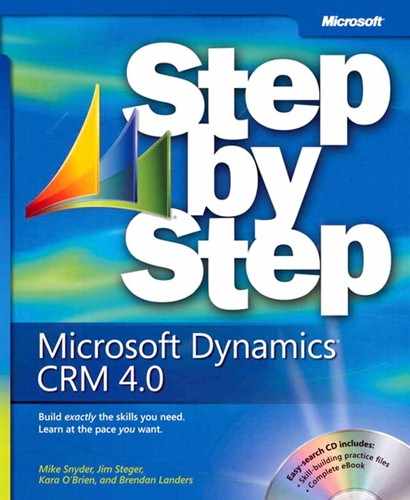If you install Microsoft Dynamics CRM for Outlook with Offline Access, you have the option to work with your Microsoft Dynamics CRM data when you are disconnected from the server. This feature is useful if you need to travel for onsite customer meetings or other activities, because you can look up your existing notes, add new notes, run reports, and do much more without needing an Internet connection. The concept of disconnecting from the Microsoft Dynamics CRM server is known as going offline. When you go offline, Microsoft Dynamics CRM for Outlook copies a subset of the Microsoft Dynamics CRM database to your computer. While offline, you can perform almost all of the Microsoft Dynamics CRM functionality just the same as when you’re online. When you are able to connect to the Microsoft Dynamics CRM server again, you go online to synchronize your offline database with the main Microsoft Dynamics CRM database. When you go online, Microsoft Dynamics CRM for Outlook automatically determines which records it should upload to the Microsoft Dynamics CRM database and which records it needs to synchronize with your local database.
Because some Microsoft Dynamics CRM databases can get quite large, going offline does not copy all of the data to your computer. Instead, Microsoft Dynamics CRM for Outlook uses local data groups to determine which subsets of the database it should copy to the offline database. The use of local data groups provides better performance and faster synchronization times than if you were using the entire Microsoft Dynamics CRM database.
Tip
You can configure Microsoft Dynamics CRM for Outlook with Offline Access to perform a background update of your local data as often as every 15 minutes. Setting up this option in the Microsoft Dynamics CRM for Outlook options allows you to go offline more quickly in the future, in addition to allowing you to access relatively updated offline data in case you forget to explicitly go offline.
In this exercise, you will go offline and confirm you are disconnected from the Microsoft Dynamics CRM server.
Note
BE SURE TO start Outlook with Microsoft Dynamics CRM for Outlook installed, if necessary, before beginning this exercise.
In the Outlook CRM toolbar, click the Go Offline button.
A progress window appears, showing you the status of the synchronization process.
When the process is complete, the Go Offline button on the CRM toolbar is renamed Go Online. This indicates that you are now working with data from the local database instead of data from the Microsoft Dynamics CRM server.
In the Outlook menu bar, click the Go menu, and select Folder List. Scroll down past your mailbox to the Microsoft Dynamics CRM folder. Click the + symbol to expand the folder.
Click the + symbol to expand the Sales folder, and then click the Accounts folder.
You will see a list of accounts, just as if you were viewing them while connected to the Microsoft Dynamics CRM server. Depending on your local data groups, you might see only a subset of all of the Microsoft Dynamics CRM accounts.
To confirm that you are working offline, double-click an account record to open it. When the account record is open in Internet Explorer, press
 on the keyboard.
on the keyboard.The Internet Explorer address bar appears. If you examine the Web address of the account record, you will notice that it starts with http://localhost:2525 instead of the typical Web address that you use to access Microsoft Dynamics CRM. This localhost address references the offline version of Microsoft Dynamics CRM, so you know that you’re working offline.
Click the Go Online button to reconnect to the Microsoft Dynamics CRM server.


